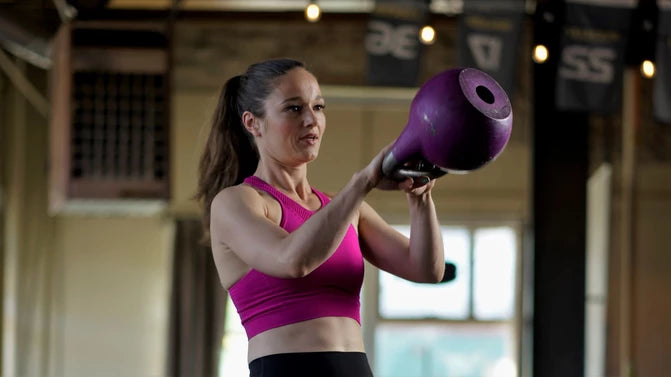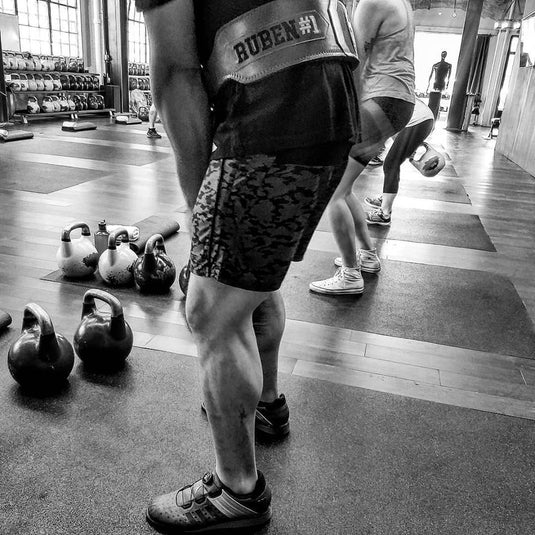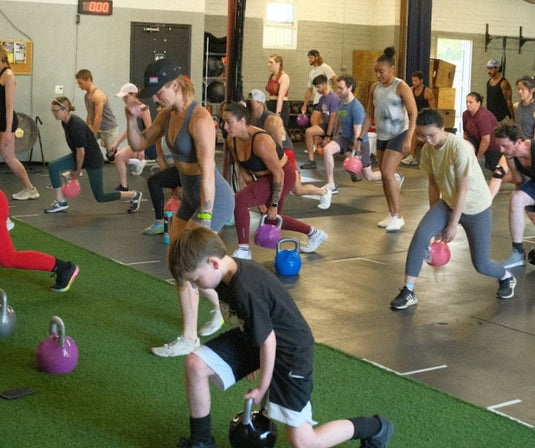How to Do a Kettlebell Swing Correctly


Whether you are working out from home or heading to the gym to exercise, one thing always remains true - you must use proper technique to stay healthy and achieve both short and long-term success from your routines. Learning how to do kettlebell swings correctly is no different.
Even if you are out of shape or you’ve never touched a kettlebell, it does not mean you can’t perform a kettlebell swing the right way. You may even be surprised to learn that it takes little to no arm strength whatsoever. Kettlebell swings are awesome for building strength through your core and whole posterior chain at the same time while providing "sneaky cardio."
Ready to learn how to do a kettlebell swing correctly? Check out these tips before your next workout:
Step 1. Prepare Yourself and the Space
Make sure you have plenty of room in front and behind you, and that the surface you are working on is firm. You may want to set your kettlebell on a mat to protect your floor. You can either be barefoot or wearing shoes, but shoes should have a firm sole, like converse.
Step 2. Find your Stance

Place the kettlebell between your feet (under your center of mass). Stand a little wider than shoulder-distance apart, with your toes pointed slightly outward.
As you squat/hinge down to pick up your kettlebell, keep your knees tracking the same direction as your toes, and to the best of your ability keep your:
-
shoulders back
-
back straight (vs. rounding/hunching forward)
-
chest up (vs. bending totally over)
Pick up your kettlebell with both hands, push your heels into the ground and stand up nice and tall at the top. To lower, push your hips back out of the way and return it to the floor again while again keeping your shoulders back, chest up and lumbar flat.
Step 3. Practice the “Hike”

The kettlebell swing begins with hiking the kettlebell from the floor in front of you to the highest point between your legs behind you - before standing up quickly and completing consecutive swings from the standing position. It is important to nail this “take-off,” or "hike," to set up your swing for success, so let’s practice it a few times before proceeding with the swings.
-
Stand 12-18” behind your kettlebell with your feet in the optimal position you just determined by doing deadlifts.
-
Bend your knees and hinge forward just until you can hook the kettlebell handle with your fingers while keeping your arms straight, your shoulders back, lumbar flat, and chest up. Your back should be at a 45-degree angle to the ground.
-
Squeeze your lats and hike the kettlebell as high as you can behind you, between your legs. Your wrists should be as high as possible between your legs, so that your arms come in total contact with your torso and your wrists make contact with your groin.
-
Hold the position and let the kettlebell swing back to the floor where it started. You can stand up and shake it out between reps but repeat this move until you feel confident to add the next step. If you are keeping your shoulders back, chest up, and weight in your heels throughout this drill, you should not have any discomfort in your back.
Step 4: Practice the Up Swing

Now that you’ve hiked the kettlebell to its highest point behind you, you’re going to use your lower body to assist the natural momentum of its return into a swing. To do this, keep it high between your legs, and keep your arms connected to your torso as long as you can.
After the hike, as the kettlebell begins to descend, squeeze your glutes, stand up and give the kettlebell a gentle hip thrust off your body. As the bell swings upward, it will pull your arms off of your body - your arms are only guiding the bell, not lifting it - your lower body already powered the swing. The more energy you use when squeezing your glutes, standing up, and giving that hip thrust off, the higher the kettlebell will fly.
Aim to give it just enough energy so that the kettlebell floats to chest height. A gentle bend to your elbows once it approaches waist-high will keep the kettlebell a little closer to you. Pull your arms back into your torso and direct the kettlebell back between your legs and return it to its starting position on the floor. This is called a stop swing, also known as a dead swing.
Step 5: Put It Together and Get Swinging

At the apex of the swing, your arms are outstretched (they can be straight, or we prefer that slight bend to your elbows to keep the kettlebell a little closer to you), your shoulder blades are retracted, and you’re standing up tall. Here are the intricacies - some basic, some advanced - that will help you swing like a pro.
-
Once the kettlebell is weightless at the apex of the swing, prepare for its descent by bracing yourself for the extra force of the falling kettlebell. We do this by what we call counterbalancing; it is a technique which takes load off your back and transfers it to your lower body instead.
-
With a light weight, all you need to do is shift your weight into your heels a bit, so that as the bell falls in front of you, it doesn’t try to pull you forward, potentially putting strain on your lumbar. The heavier your kettlebell, the more you will want to counterbalance – it’s like you’re playing ring-around-the-rosey with the kettlebell. So, if it is a light or medium weight, shifting your weight into your heels may be enough. But if you’re going heavy – let’s say 70 pounds because that’s how you roll – you’ll counterbalance by leaning back with 70 pounds of your own body weight as the bell falls into the back swing. It becomes a visible lean back in that case.
-
As the kettlebell begins to fall, your fingertips are gently hooked around the handle (no death-grip here). Straighten your arms and pull them into your body as you guide the kettlebell as high as you can between your legs.
-
As the bell continues its path behind you to complete its pendulum, you will let your hips move back, legs straighten, and upper body lean forward only as much as needed to allow the kettlebell to finish its arc.
-
Bend your knees slightly and stand back up as you repeat the process.
Swing Workouts
It takes months of regular practice to really nail how to do kettlebell swings, so don't be discouraged if they don't feel natural at first. But if you've followed these steps, you can start doing them regularly, learn all of the variations, and definitely start incorporating kettlebell swings into a workout with our favorite finisher; the Two-Hand Swing and Push Up “Race to Zero.”
Complete ten swings followed by ten pushups. Then deduct one rep each round (e.g., nine swings, nine pushups, eight swings, eight pushups) until you get to zero. Set your timer and see how long it takes you. Once you can complete it in 4 minutes, you’ve reached hero level, and it is probably time to use a slightly heavier kettlebell on your next attempt!

Ready to Train? Invest in a New Kettlebell
Pro Kettlebell has exactly what you need if you are in the market for a new kettlebell. We have comfortable, multifunctional kettlebells that will help you lift like a pro and achieve optimal results.
Browse through our kettlebell store today to start your next fitness journey.






